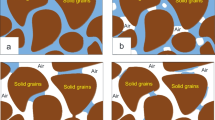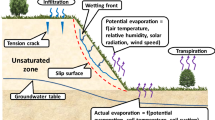Abstract
After reviewing the studies on the lateral artificial boundaries in dynamic soil-structure interactions, the free field boundary was theoretically analyzed in asymmetric- and symmetric-matrix forms. First, the lumped mass system was combined with viscous or viscoelastic elements to obtain a lumped mass-free field boundary. Second, typical examples were implemented using the finite element software ABAQUS. The incident shear wave was taken to be perpendicular to the bottom to verify the effectiveness of the lumped mass-free field under various sites: underground structures, uniform sites, and layered sites. Finally, the accuracy of the lumped mass-free field boundary was compared with those of the viscoelastic and roller boundaries on different calculation scales, soil damping ratios, structure sizes, and ground motion characteristics. Subsequently, the engineering design values for different damping ratios are given. The results show that the precision of the lumped mass-free field boundary was reasonable, and the operation was simple within the same engineering application.
Similar content being viewed by others
References
Alterman ZS, Aboudi J and Karal FC (1970), “Pulse Propagation in a Laterally Heterogeneous Solid Elastic Sphere”, Geophysical Journal International, 21(3): 243–260. doi: https://doi.org/10.1111/j.1365-246X.1970.tb01790.x
Bouckovalas GD and Papadimitriou AG (2005), “Numerical Evaluation of Slope Topography Effects on Seismic Ground Motion”, Soil Dynamics and Earthquake Engineering, 25(7–10): 547–558. doi: https://doi.org/10.1016/j.soildyn.2004.11.008
Carranza-Torres C and Fairhurst C (1999), “The Elasto-Plastic Response of Underground Excavations in Rock Masses That Satisfy the Hoek—Brown Failure Criterion”, International Journal of Rock Mechanics and Mining Sciences, 36(6): 777–809. doi: https://doi.org/10.1016/s0148-9062(99)00047-9
Chow YK and Smith IM (2010), “Static and Periodic Infinite Solid Elements”, International Journal for Numerical Methods in Engineering, 17(4): 503–526. doi: https://doi.org/10.1002/nme.1620170403
Deeks AJ and Randolph MF (1994), “Axisymmetric Time-Domain Transmitting Boundaries”, Journal of Engineering Mechanics, 120(1): 25–42. doi: https://doi.org/10.1061/(ASCE)0733-9399(1994)120:1(25)
Dong ZF, Zhu HY, Yan C and Zheng B (2018), “Determination of the Width of Simplified Lateral Boundaries in the Plane Problem of Underground Structures”, Journal of Vibration and Shock, 35(6): 218–224. (in Chinese)
Du XL 2009, Theories and Methods of Wave Motion for Engineering, Science Press, Beijing, China. (in Chinese)
Du XL and Zhao M (2010), “A Local Time-Domain Transmitting Boundary for Simulating Cylindrical Elastic Wave Propagation in Infinite Media”, Soil Dynamics and Earthquake Engineering, 30(10): 937–946. doi: https://doi.org/10.1016/j.soildyn.2010.04.004
Du XL, Zhao M and Wang JT (2006), “A Stress Artificial Boundary in FEA for Near-Field Wave Problem”, Chinese Journal of Theoretical & Applied Mechanics, 38(1): 49–56. doi: https://doi.org/10.1016/j.mineng.2005.09.006 (in Chinese)
Hashash YM, Hook JJ, Schmidt B, John I and Yao C (2001), “Seismic Design and Analysis of Underground Structures”, Tunnelling and Underground Space Technology, 16(4): 247–293. doi: https://doi.org/10.1016/S0886-7798(01)00051-7
Itasca Consulting Group (2008), 3DEC-3Dimensional Distinct Element Code DB/CD. Minneapolis, Minnesota, USA.
Joyner WB and Chen AT (1975), “Calculation of Nonlinear Ground Response in Earthquakes”, Bulletin of the Seismological Society of America, 65(5): 1315–1336.
Kong G, Ding HP, Jin X, Zhou J and Zhang DY (2005), “The Application of Multi-Transmitting Boundary in ANSYS”, Earthquake Resistant Engineering and Retrofitting, 27(2): 26, 67–70. (in Chinese)
Li ST, Liu JB, Bao X, Jia YF, Xiao L, Tao XG, Chen YC and Zhang WF (2020), “Stability Analysis of an Explicit Integration Algorithm with 3D Viscoelastic Artificial Boundary Elements”, Mathematical Problems in Engineering, 2020: 1848169. doi: https://doi.org/10.1155/2020/1848169
Liao ZP, Yang BP and Yuan YF (1982), “Artificial Boundary SN Analysis of Transient Elastic Wave Propagation”, Earthquake Engineering and Engineering Vibration, 2(1): 1–11. (in Chinese)
Liu JB, Du YX, Du XL, Wang ZY and Wu J (2006), “3D Viscous-Spring Artificial Boundary in Time Domain”, Earthquake Engineering and Engineering Vibration, 5(1): 93–102. doi: https://doi.org/10.1007/s11803-006-0585-2
Liu JB and Lu YD (1998), “A Direct Method for Analysis of Dynamic Soil-Structure Interaction Based on Interface Idea”, Developments in Geotechnical Engineering, 83: 261–276. doi: https://doi.org/10.1016/S0165-1250(98)80018-7
Liu JB, Tan H, Bao X, Wang DY and Li ST (2019), “Seismic Wave Input Method for Three-Dimensional Soil-Structure Dynamic Interaction Analysis Based on the Substructure of Artificial Boundaries”, Earthquake Engineering and Engineering Vibration, 18(4): 747–758. doi: https://doi.org/10.1007/s11803-019-0534-5
Liu JB, Wang ZY, Du XL and Du YX (2005), “Three-Dimensional Visco-Elastic Artificial Boundaries in Time Domain for Wave Motion Problems”, Engineering Mechanics, 22(6): 46–51. doi: https://doi.org/10.1360/biodiv.050084.(in Chinese)
Lysmer J and Kuhlemeyer RL (1969), “Finite Dynamic Model for Infinite Media”, Journal of the Engineering Mechanics Division, 95(4): 859–878.
Nakamura N (2012), “Two-Dimensional Energy Transmitting Boundary in the Time Domain”, Earthquakes and Structures, 3(2): 97–115. doi: https://doi.org/10.12989/eas.2012.3.2.097
Nielsen AH (2006), “Absorbing Boundary Conditions for Seismic Analysis in ABAQUS,” ABAQUS Users’ Conference, 359–376.
Nielsen AH (2014), “Towards a Complete Framework for Seismic Analysis in ABAQUS”, Proceedings of the Institution of Civil Engineers — Engineering and Computational Mechanics, 167(1): 3–12.
Pelekis P, Batilas A, Pefani E, Vlachakis V and Athanasopoulos G (2017), “Surface Topography and Site Stratigraphy Effects on the Seismic Response of a Slope in the Achaia-Ilia (Greece) 2008 Mw6.4 Earthquake”, Soil Dynamics and Earthquake Engineering, 100: 538–554. doi: https://doi.org/10.1016/j.soildyn.2017.05.038
Rizzitano S, Cascone E and Biondi G (2014), “Coupling of Topographic and Stratigraphic Effects on Seismic Response of Slopes Through 2D Linear and Equivalent Linear Analyses”, Soil Dynamics and Earthquake Engineering, 67: 66–84. doi: https://doi.org/10.1016/j.soildyn.2014.09.003
Seed HB, Martin PP and Lysmer J 1975, The Generation and Dissipation of Pore Water Pressures During Soil Liquefaction, Berkeley, USA: EERC, UC Berkeley.
Tripe R, Kontoe S and Wong TKC (2013), “Slope Topography Effects on Ground Motion in the Presence of Deep Soil Layers”, Soil Dynamics and Earthquake Engineering, 50: 72–84. doi: https://doi.org/10.1016/j.soildyn.2013.02.011
Ungless RF 1973, An Infinite Finite Element, University of British Columbia, Vancouver, Canada.
Wang JJ, Huang Y, Dong ZF and Zhao M 2019, Seismic Design of Urban Rail Transit Structures, China Architecture Building Press, Beijing, China. (in Chinese)
Wolf JP 1985, Dynamic Soil-Structure Interaction, Prentice Hall Inc., Englewood Cliffs New Jersey, USA.
Wolf JP (1989), “Soil-Structure-Interaction Analysis in Time Domain”, Nuclear Engineering and Design, 111(3): 381–393.
Xu Q, Chen JY, Li J and Fan SL (2012), “New Artificial Boundary Condition for Saturated Soil Foundations”, Earthquake Engineering and Engineering Vibration, 11(1): 139–147. doi: https://doi.org/10.1007/s11803-012-0105-5
Yang Y, Li XJ, He QM and Ji ZH (2014), “Comparison of Measures for Eliminating Drift Instability of Transmitting Boundary in Scattering Problems”, Earthquake Engineering and Engineering Vibration, 34(5): 1–6. (in Chinese)
Yasui H, Kiyoshima J and Ushijim H (1995), “Passive Protection Against Rotavirus-Induced Diarrhea of Mouse Pups Born to and Nursed by Dams Fed Bifidobacterium Breve YIT4064”, Journal of Infectious Diseases, 172(2): 403–409. doi: https://doi.org/10.1093/infdis/172.2.403
Zhang CH and Zhao CB (1987), “Coupling Method of Finite and Infinite Elements for Strip Foundation Wave Problems”, Earthquake Engineering and Structural Dynamics, 15(7): 839–851. doi: https://doi.org/10.1002/eqe.4290150705
Zhao M (2009), “Boundary Condition for Finite-Element Simulation of Near-Field Wave Motion and Its Engineering Application”, PhD Dissertation, Beijing University of Technology, Beijing, China.
Zhao M, Du XL, Liu JB and Han Q (2013), “Time-Domain Method for Free Field in Layered Half Space Under P-SV Waves of Oblique Incidence”, China Earthquake Engineering Journal, 35(1): 84–90.
Zhao M, Wang LT, Gao ZD, Du XL and Huang JQ (2017), “Comparison of Earthquake Input Methods in Soil-Structure Interaction Analysis”, Earthquake Defense Technology, 12(3): 589–598.
Zhao M, Yin HQ, Du XL, Liu JB and Liang LY (2015), “1D Finite Element Artificial Boundary Method for Layered Half Space Site Response from Obliquely Incident Earthquake”, Earthquakes and Structures, 9(1): 173. doi: https://doi.org/10.12989/eas.2015.9.1.173
Zhuang HY and Chen GX 2017, Seismic Resistance of Underground Metro Structures, Science Press, Beijing, China. (in Chinese)
Zienkiewicz OC, Bando K, Bettess P, Emson C, Chiam TC (1985), “Mapped Infinite Elements for Exterior Wave Problems”, International Journal for Numerical Methods in Engineering, 21(7): 1229–1251. doi: https://doi.org/10.1002/nme.1620210705
Author information
Authors and Affiliations
Corresponding author
Additional information
Supported by: Natural Science Foundation of Henan Province under Grant No. 222300420415
Rights and permissions
About this article
Cite this article
Dong, Z., Kuo, C., Shi, C. et al. Simplified lateral free field boundary based on a lumped mass system. Earthq. Eng. Eng. Vib. 21, 913–928 (2022). https://doi.org/10.1007/s11803-022-2124-1
Received:
Accepted:
Published:
Issue Date:
DOI: https://doi.org/10.1007/s11803-022-2124-1




